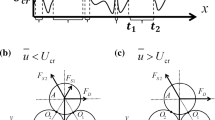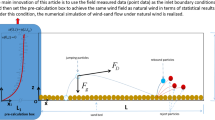Abstract.
In a wind-blown sand layer, it has been found that wind transport of particles is always associated with separation of electric charge. This electrification in turn produces some electrostatic forces in addition to the gravitational and fluid friction forces that affect the movement of saltating sand particles, further, the wind-blown sand saltation. To evaluate this effect quantitatively, this paper presents a simulation of evolution of wind-blown sand grains after the electrostatic forces exerted on the grains are taken into account in the wind feedback mechanism of wind-blown saltation. That is, the coupling interaction between the wind flow and the saltating sand particles is employed in the simulation to the non-stationary wind and sand flows when considering fluid drag, gravitation, and a kind of electrostatic force generated from a distribution of electric field changing with time in the evolution process of the sand saltation. On the basis of the proposed simulation model, a numerical program is given to perform the simulation of this dynamic process and some characteristic quantities, e.g., duration of the system to reach the steady state, and curves of the saltating grain number, grain transport rate, mass-flux profile, and wind profile varying with time during the non-stationary evolution are displayed. The obtained numerical results exhibit that the electrostatic force is closely related to the average charge-to-mass ratio of sand particles and has obvious influence on these characteristic quantities. The obtained results also show that the duration of the system to reach the steady state, the sand transport rate and the mass flux profile coincide well with experimental results by Shao and Raupach (1992) when the average charge-to-mass ratio of sand particles is 60 μC/kg for the sand particles with average diameter of 0.25 mm. When the average charge-to-mass ratios of sand particles are taken as some other certain values, the calculation results still show that the mass flux profiles are well in agreement with the experimental data by Rasmussen and Mikkelsen (1998) for another category of sand particles, which tell us that the electrostatic force is one of main factors that have to be considered in the research of mechanism of wind-blown sand saltation.
Similar content being viewed by others
References
R.A. Bagnold, The physics of blown sand and desert dunes (London, Methuen, 1941)
P.R. Owen, J. Fluid Mech. 20, 225 (1964)
R.S. Anderson, P.K. Haff, Science 241, 820 (1988)
R.S. Anderson, M. Sorensen, B.B. Willets, A review of recent progress in our understanding of Aeolian sediment transport, edited by Barndorff-Nielsen et al., International Workshop on the Physica of Blown Sand: Acta Mechanica, Suppl. 1 (1991)
Y. Shao, Physics and modeling of wind erosion (Kluwer Academic Publishers, Boston, 2000)
M. Sorensen, Geomorphology 59, 53 (2004)
I.K. McEwan, B.J. Befcoate, B.B. Willetts, Sedimentology 46, 407 (1999)
P.J. Spies, I.K. McEwan, Earth Surface Processes and Landforms 25, 437 (2000)
I.K. McEwan, B.B. Willetts, Acta Mech., Suppl. 1, 53 (1991)
I.K. McEwan, B.B. Willetts, J. Fluid Mech. 252, 99 (1993)
Y. Shao, A. Li, Boundary-Layer Meteorol. 91, 199 (1999)
P.J. Spies, I.K. McEwan, G.R. Butterfield, Earth Surface Processes and Landforms 25, 505 (2000)
B.R. White, J.C. Schulz, J. Fluid Mech. 81, 497 (1977)
Y. Shao, M.R. Raupach, J. Geophys. Res. 98, 12719 (1993)
D.S. Schmidt, A.S. Schmidt, J.D. Dent, J. Geophys. Res. 103, 8997 (1998)
I. Livingstone, A. Warren, Aeolian Geomorphology: An Introduction (Addison Wesley Lonman Limited, London, 1996), p. 211
R.S. Anderson, P.K. Haff, Wind modification and bed response during saltation of sand in air, edited by Barndorff-Nielsen et al.: International Workshop on the Physics of Blown Sand: Acta Mechanica, Suppl. 1, 21 (1991)
R. Greeley, R.A. Leach, prelimilary assessment of the effects of electrostatics on Aeolian process, Rep. Planet. Geol. Program, 1977–1978, NASA TM 79729: 236 (1978)
J. Latham, Q. J. R. Meteorol. Soc. 90, 91 (1964)
R. Greeley, J.D. Iversen, Wind as a Geological Proceeding on Earth, Mars, Venus and Titan (Cambridge University Press, London, 1985)
X.J. Zheng, N. Huang, Y.H. Zhou, J. Geophys. Res. 108, 4322 (2003)
P.E. Shaw, J.N. Chubb, London Ser. A 122, 48 (1929)
E.W.B. Gill, Nature 162, 568 (1948)
W.D. Crozier, J. Geophys. Res. 69, 5427 (1964)
A.K. Kamra, Weather 24, 145 (1969)
G.D. Freier, J. Geophys. Res. 65, 3504 (1960)
J.D. Iversen, J. Glaciology 28, 393 (1980)
S.F. Singer, E.H. Walker, Icarus 1, 112 (1962)
B.R. White, B.M. Lacchia, R. Greeley, R.N. Leach, J. Geophys. Res. 102, 25629 (1997)
A.A. Sickafoose, J.E. Colwell, M. Horányi, S. Robertson, J. Geophys. Res. 106 8343 (2001)
C.E. Krauss, M. Horányi, S. Robertso, New J. Phys. 5, 70 (2003)
D.V. Nalivkin, Hurricanes, storms and tornadoes, edited by A.A. Balkema (Rotterdam: 1983), p. 580
D.K. Davies, S.P. Kendall, J. Electrostatica 13, 81 (1982)
S.P. Kanagy II, C.J. Mann, Earth-Science Rev. 36, 181 (1994)
D. Krinsley, R. Greeley, Sediment. Geol. 47, 167 (1986)
E.E. Donaldson, J.T. Dicknson, S.K. Bhattacharya, J. Adhesion 25, 281 (1988)
T. Gold, Processes on the lunar surface, edited by Z. Kopal, Z.K. Mikhailov, The Moon (Academic Press, N.Y., 1962), 433
R.F. Scott, Soil mechanics considerations in the testing of lunar soil models, edited by J.W. Salibury and P.E. Glaser, The lunar Surface Layer (Academic Press, N.Y., 1964), p. 1
J.F. Lindsay, Lunar stratigraphy and Sedimentology, (Elsevier, N.Y., 1976), p. 302
C.K. Adams, Nature's electricity, TAB Books, Blue Ridge Summit, PA, 147 (1987)
C.R. Buhler, C.I. Calle, A.W. Nowicki, M.L. Ritz, J.G. Mantovani (2004), Results of a wheel electrometer for measuring the triboelectric properties of Martine Regolith. 35th Lunar and Planetary Science Conference, League City, Texas
A.A. Mills, Nature 268, 614 (1977)
S. Israelsson, J. Atmos. Terr. Phys. 56, 1551 (1994)
M. Horanyi, G. Lawrence, Phys. Scr. T89, 130 (2001)
C.D. Stow, Weather 24, 134 (1969)
D.S. Schmidt, J.D. Dent, Ann. Glaciol. 18, 234 (1993)
X.J. Zheng, L.H. He, Y.H. Zhou, J. Geophys. Res. 109, D15208 (2004)
R.S. Anderson, B. Hallet, Bull. Geol. Soc. Amer. 97, 523 (1986)
M. Sorensen, Estimation of some aeolian saltation transport parameters from transport rate profiles, edited by O.E. Barndorff-Nielsen et al., Proceedings of International Workshop on the Physics of Blown Sand, Memoirs No. 8, Vol. 1. Dept. Theor. Statist., Aarhus Univ., Denmark, 141 (1985)
Y. Shao, M.R. Raupach, J. Geophys. Res. 97, 20559 (1992)
J.R. Garrett, The atmospheric boundary layer (London, Cambridge University Press, 1994)
K.R. Rasmussen, J.D. Iversen, P. Rautahemio, Geomorphology 17, 19 (1996)
K.R. Rasmussen, H.E. Mikkelsen, Sedimentology 45, 789 (1998)
Z.S. Li, J.R. Ni, Geomorphology 52, 243 (2003)
Author information
Authors and Affiliations
Corresponding author
Rights and permissions
About this article
Cite this article
Zheng, X., Huang, N. & Zhou, Y. The effect of electrostatic force on the evolution of sand saltation cloud. Eur. Phys. J. E 19, 129–138 (2006). https://doi.org/10.1140/epje/e2006-00020-9
Received:
Published:
Issue Date:
DOI: https://doi.org/10.1140/epje/e2006-00020-9




